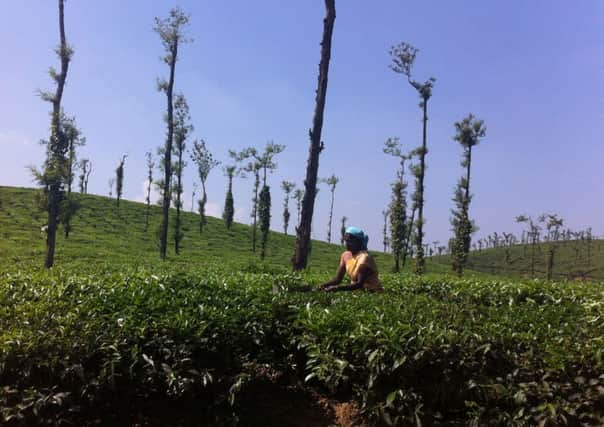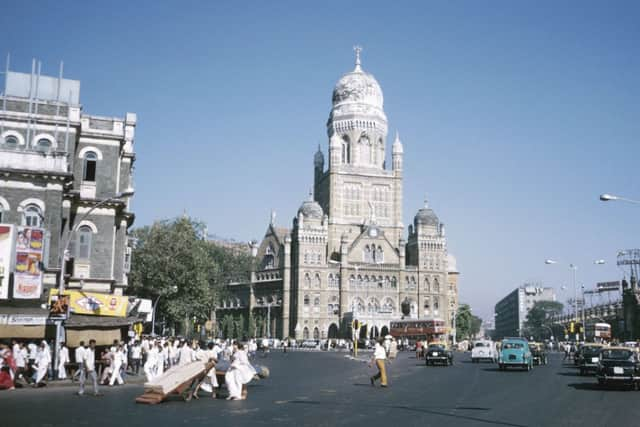Following the tea trail to India


A dozen young women chatter as they furiously shear bright leaves from tea plants that stretch like a green carpet across the plantation.
Their saris and gold necklaces glisten in the sun as they fill huge brown sacks to be taken back to the on-site factory and weighed.
Advertisement
Hide AdAdvertisement
Hide AdMore than 300 families live and work in the fields and know little of the hustle and bustle of life outside the plantation. Their washing lines waft in the breeze at the front of their wooden houses, which are a short walk away from an onsite medical centre built for the workers.


The employees work eight hours a day picking leaves in a 365-day operation in the only tea plantation in Coorg. While production is mainly confined to the north of India because the weather conditions are better, the importance of tea to Indian culture is evident no matter what part of the country you are in.
“Tea is a part of Indian life,” says Gautam Prakash, head of Plantation Trails at Tata Coffee Limited. “It’s the beverage of choice. It’s part of every meal. You start the day in the morning with a nice cup of tea and it will be served throughout the day.”
Sipping my second cup on the veranda of the colonial-style Cottabetta Bungalow, I feel like I’ve stepped back in time to 19th-century India. Once occupied by British planters, the bungalow is hidden away among 1,000 acres of coffee plantations owned by Tata.
Advertisement
Hide AdAdvertisement
Hide AdOnly a roaring bonfire spoils the absolute silence of the garden, which is rich in vegetation and has spectacular views of the surrounding mountains.
During a guided jeep tour of the plantations, I watch birds flutter between the 200-year-old trees that extend upwards from the dark coffee bushes that stretch for 1,200 acres.
But it is a slight disappointment to learn from our guide that the luscious grounds cannot be explored on foot. He informs me that it’s for my own safety – so I don’t encounter any of the wild elephants that come to feast on the jackfruit trees.
The region of Coorg is not the first choice for international tourists – particularly as it involves a treacherous seven-hour drive along heavily potholed roads from Bangalore airport.
Advertisement
Hide AdAdvertisement
Hide AdBut as I soak in the infinity pool at the Vivanta by Taj Hotel, I feel the knots in my muscles melt away while overlooking the rolling hills of the rainforest.
The resort has been open for less than a year and boasts 62 impressive cottages, which are dotted among the trees.
A huge amount of love and attention was given to the resort so that it complements the natural surroundings and gives its guests a feeling of tranquillity and peace.
While exploring the grounds, I’m greeted by a man known as the ‘Colonel’ who looks after an on-site museum dedicated to the history of Coorg.
Advertisement
Hide AdAdvertisement
Hide AdHis passion is infectious as he regales folkloric tales about the region.
In true India style, the conversation naturally shifts to the subject of tea.
“Tea is very important to Indian culture,” he says. “Everybody gets up in the morning and has a cup of tea.
“The feeling among tea drinkers is that it wakes you up and gets your system working.”
Advertisement
Hide AdAdvertisement
Hide AdI quickly discover that the spicy Masala Chai tea is the most popular choice among Indians, but for an English palate like mine, it’s an acquired taste.
But I find a variety of tea flavours to satisfy my cravings during Indian afternoon high tea at the 125-year-old Taj West End Hotel in Bangalore.
I opt for the strong Assam variety as I tuck into a soft kheema samosa and gunpowder idli. The Indian version of high tea has only been on offer for a month at the hotel but is already proving popular with tourists.
“Indian high tea doesn’t exist traditionally,” explains assistant restaurant manager Gayatri Vijay Kale. “But we found that it’s popular with locals who want the high tea experience but with Indian street food. They like it because the food has more flavour than the English version.
Advertisement
Hide AdAdvertisement
Hide Ad“It’s popular with foreigners who want to experience a taste of India too.”
Drinking tea is a hugely social event in India and nowhere is this more evident than in the bustling city of Mumbai.
Every street corner is littered with traditional Parsi cafes where families, friends, couples and businessmen come to enjoy a cheap and cheerful meal washed down with tea. Sitting in the Britannia cafe, a cardboard cut-out of Prince William and Kate Middleton looks down from above as I sip on a cup of Darjeeling tea. Its strong taste complements the sweet flavours of the chicken berry pilau dish that I happily tuck into.
“When you go back to England, can you give Prince George a kiss for me?” asks 91-year-old owner and fierce royalist Boman Kohinoor. “And tell the Queen we want her to come back to India.”
Advertisement
Hide AdAdvertisement
Hide AdThe Queen is known to enjoy a fresh pot of Darjeeling tea as a wake-up call, so it wouldn’t surprise me if she wanted to return herself.
British rule in India may have ended in 1947 but its influences in the country have had a lasting impression – particularly with the introduction of tea as a popular choice of drink.
And after enjoying a fabulous stay in southern India, it’s safe to say the favour has been returned.
Knowing how much work and effort goes into creating the drink, I think I’ll appreciate my morning cuppa even more.